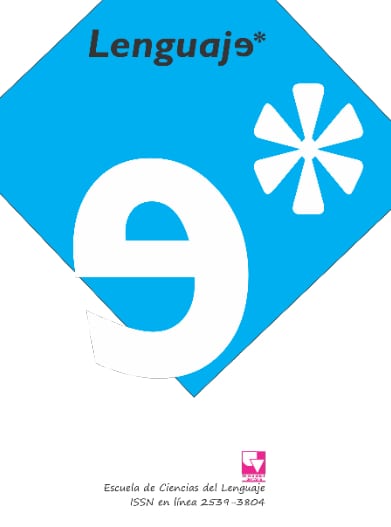Género y estrato socioeconómico, ¿factores determinantes en el número y tipo de errores escritos del inglés como lengua extranjera?
Contenido principal del artículo
Este artículo presenta el análisis estadístico de los errores de escritura en un corpus de estudiantes de inglés como lengua extranjera (ILE) a nivel universitario. Se busca establecer si existe relación entre los principales errores de las composiciones escritas y dos factores sociodemográficos: género y estrato. Los participantes fueron clasificados en los niveles B1 y B2 según el Marco Común Europeo de Referencia (MCER) El corpus se compiló siguiendo los procedimientos de la Lingüística de Corpus Computacional (LCC) y los errores se analizaron conforme al método de análisis de errores y codificados de acuerdo con el sistema de anotación de errores de la Universidad de Lovaina versión 1.2. Según los hallazgos, los errores más prevalentes en hombres y mujeres pertenecen a las categorías Forma, Deletreado (FS), Artículo Gramatical (GA) y Léxico (LS). De igual forma, de acuerdo con los resultados el error con más prevalencia en el estrato 1 y 2 del nivel B2 es Artículo Gramatical (GA). En este mismo nivel, en los estratos 3, 4, 5 y 6 el error con más prevalencia es Léxico (LS). Se ofrece una vista general de los resultados que forman parte de una tesis doctoral.
Aliakbari, M., y Mahjub, E. (2010). Analytical/intuitive EFL learners and gender effect. International Journal of Pedagogies and Learning, 6(1), 41-48. https://doi.org/10.5172/ijpl.6.1.41.
Arikan, A. (2011). Prospective English Language Teachers’ Perceptions of the Target Language and Culture in Relation to their Socioeconomic Status. English Language Teaching, 4(3), 232-242. https://doi.org/10.5539/elt.v4n3p232.
Babayiğit, S. (2015). The dimensions of written expression: Language group and gender differences. Learning and Instruction, 35, 33-41. https://doi.org/10.1016/j.learninstruc.2014.08.006.
Benavides, C. (2014). Lexicalization and Spanish derivational morphology. Research in Corpus Linguistics, 2, 1-14. https://doi.org/10.32714/ricl.02.01.
Berglind, E. (2017). Evidentiality across age and gender: a corpus-based study of variation in spoken British English. Research in Corpus Linguistics, 5, 17-33. https://doi.org/10.32714/ricl.05.02.
Bernstein, B. (1971). Class, Codes and Contro. Volume I: Theoretical Studies towards a Sociology of Language. Routledge.
Bourdieu, P. (1997). Capital cultural, escuela y espacio social (Comp. Trad. I. Jiménez). Siglo Veintiuno Editores.
Brezina, V., McEnery, T., y Wattam, S. (2015). Collocations in context: A new perspective on collocation networks. International Journal of Corpus Linguistics, 20(2), 139-173. https://doi.org/10.1075/ijcl.20.2.01bre.
Carrió, M., y Mestre, E. (2013). A proposal for the tagging of grammatical and pragmatic errors. Research in Corpus Linguistics, 1, 7-16. https://doi.org/10.32714/ricl.01.02.
Corder, S. (1981). Error Analysis and Interlanguage. Oxford University Press.
Council of Europe. (2001). Common European Framework of Reference for Languages: Learning, teaching, assessment. Press Syndicate of the University of Cambridge.
Crespo, M. (2016). Analysis of parameters on author attribution of Spanish electronic short texts. Research in Corpus Linguistics, 4, 25-32. https://doi.org/10.32714/ricl.04.03.
Dagneaux, E., Granger, S., Meunier, F., Thewissen, J., Denness, S., y Neff, J. (2005). Error Tagging Manual Version 1.2. Université Catholique de Louvain.
Departamento Administrativo Nacional de Estadística. (s.f.). Estratificación socioeconómica para servicios públicos domiciliarios. Recuperado el 24 de octubre de 2018 de https://www.dane.gov.co/index.php/servicios-al-ciudadano/servicios-informacion/estratificacion-socioeconomica.
Durán, N. (2006). Exploring gender differences in the EFL classroom. Colombian Applied Linguistics Journal, (8), 123-136. https://doi.org/10.14483/22487085.174.
Eckert, P., y McConnell-Ginet, S. (2003). Language and Gender. https://doi.org/10.1017/CBO9780511791147.
Gilquin, G. (2015). From design to collection of learner corpora. En S. Granger, G. Gilquin y F. Meunier (Eds.), The Cambridge handbook of learner corpus research. (pp. 9-34). https://doi.org/10.1017/CBO9781139649414.002.
Granger, S., Gilquin, G., y Meunier, F. (Eds.). (2015). The Cambridge Handbook of Learner Corpus Research. https://doi.org/10.1017/CBO9781139649414.
Hernández, N. (2013). New media, new challenges: exploring the frontiers of corpus linguistics in the linguistics curriculum. Research in Corpus Linguistics, 1, 17-31. https://doi.org/10.32714/ricl.01.03.
Ishikawa, Y. (2015). Gender Differences in Vocabulary Use in Essay Writing by University Students. Procedia - Social and Behavioral Sciences, 192, 593-600. https://doi.org/10.1016/j.sbspro.2015.06.078.
James, C. (1998). Errors in Language Learning and Use. Exploring Error Analysis. Rouledge.
Lakoff, R. (2003a). Language, Gender, and Politics: Putting “Women” and “Power” in the Same Sentence. En J. Holmes y M. Meyerhoff (Eds.), The Handbook of Language and Gender (pp. 160-178). https://doi.org/10.1002/9780470756942.ch7.
Leech, G. (2005). Adding Linguistic Annotation. En M. Wyne (Ed.), Developing Linguistic Corpora: a Guide to Good Practice. http://users.ox.ac.uk/~martinw/dlc/chapter2.htm.
Lin, A.M.Y. (1999). Doing-English Lessons in the Reproduction or Transformation of Social Worlds? TESOL Quaterly, 33(3), 393-412. https://doi.org/10.2307/3587671.
Londoño, D. (2008). Error Analysis in a Written Composition. Profile: Issues in Teachers Professional Development, 10, 135-146. https://revistas.unal.edu.co/index.php/profile/article/view/10619.
Morales, S. (2017). Relationship between Social Context and L2 Learning of EFL Students in Terciary Level. English Language Teaching, 10(10), 87-91. https://doi.org/http://doi.org/10.5539/elt.v10n10p87.
Morales-Reyes, A., y Gómez, I. (2016). Transfer and semantic universals in the L2 acquisition of the English article system by child L2 learners. Language Acquisition, 23(1), 57-74. https://doi.org/10.1080/10489223.2015.1067318.
Pardo, M. (2019). Error Analysis in a Written Corpus of Spanish Speakers EFL Learners. A Corpus-based Study. Universidad de Antioquia.
Pardo, M., Quiroz, G., Tamayo, A., Henao, N., y Ortega, M. (2018). CLEC Colombian Learner English Corpus. Recuperado el 20 de septiembre de 2012 de https://grupotnt.udea.edu.co/clec/corpus.
Romaine, S. (2003). Variation in Language and Gender. En J. Holmes y M. Meyerhoff (Eds.), The Handbook of Language and Gender (pp. 98-118). https://doi.org/10.1002/9780470756942.ch4.
Saeed, A., Ghani, M., y Ramzan, M. (2011). Gender Difference and L2 Writing. International Research Journal of Arts and Humanities, 39(39), 29-40. https://sujo-old.usindh.edu.pk/index.php/IRJAH/article/view/1148.
Sánchez, M.E., Sevilla, Y., y Bachrach, A. (2016). Agreement processing in control and raising structures. Evidence from sentence production in Spanish. Lingua, 177, 60-77. https://doi.org/10.1016/j.lingua.2015.12.014.
Scott, M. (2005). WordSmith. http://lexically.net/wordsmith/research/.
Szabó, T. (2013). A corpus-based analysis of language ideologies in Hungarian school metalanguage. Research in Corpus Linguistics, 1, 65-79. https://ricl.aelinco.es/index.php/ricl/article/view/13.
Vandrick, S. (1995). Privileged ESL University Students. TESOL Quaterly, 29(2), 375-381. https://doi.org/10.2307/3587629.
Virtanen, T. (1996). Exploiting the International Corpus of Learner English. AFinLAn Vuosikirja, (54), 157-166. https://journal.fi/afinlavk/article/view/59762.

Esta obra está bajo una licencia internacional Creative Commons Atribución-NoComercial-SinDerivadas 4.0.





